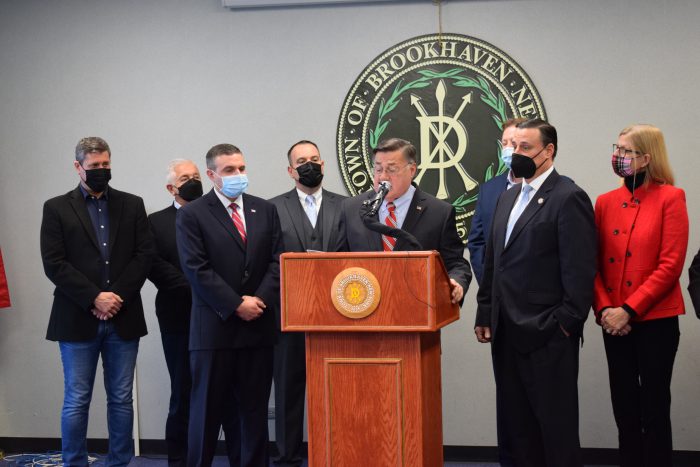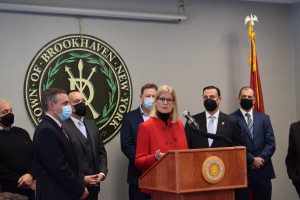The Curry Club officially has a new look, now with a water view.
Previously located in Setauket at 10 Woods Corner Road, the family behind several local eateries and venues has merged two favorites into one large palace of spice.
Indu Kaur, owner of SāGhar in Port Jefferson, said that when her family purchased the building located at 111 W. Broadway, the original plan was to eventually move The Curry Club in — but then COVID-19 happened and everything changed.
Kulwant Wadhwa, the family’s patriarch and owner of The Curry Club, kept his location the same, and everything they had planned stalled. The Wadhwa/Kaur family devoted their time to helping first responders from Riverhead to Manhattan by feeding them good, wholesome Indian cuisine as they renovated the former Harbor Grill and Schaffer’s into SāGhar — an Indian-American fusion restaurant, with a gorgeous upstairs bar overlooking the harbor.
SāGhar, translates to “Home of the Sea.”
The family is also behind The Meadow Club in Port Jefferson Station, which reopened last year after a fire devasted the catering hall back in 2018.
“So, we kind of took the challenge,” Kaur said. “And over the last year, we became well known in the community.”
Now, nearly two years after purchasing the new Port Jefferson village spot, the dream of integrating The Curry Club into SāGhar has officially become a reality.
“It’s all blended very well,” Kaur added. “It’s our story. We started from an authentic Indian restaurant, and now here we’re the next generation, adding a more modern fusion touch to the menu.”
And as of Tuesday, Feb. 8, The Curry Club at SāGhar was born.
The move

Practically overnight, Kaur said they finalized dinner in Setauket, and after sending their customers home they moved out.
Monday night, the family moved from the former location into the downstairs room. Wadhwa said that SāGhar has given them more space to cater to more people — roughly 75 seats upstairs, 55 in the Harbor Room up front, 35 in the Captain’s Room and 45 in the Schooner Room. The Curry Club at SāGhar is on the same lot where the famous Schooner Restaurant sat years ago.
The lease will officially be up at the old location on May 31, and until then the family will continue to operate The Velvet Lounge adjoining the restaurant.
But the two are excited for SāGhar’s new look. According to Kaur, a lot of it will look similar but now they will offer a full buffet — just like The Curry Club was famously known for.
“In Port Jefferson, there is nowhere where you can actually grab and go pick food, especially for nurses meaning to get out in two minutes who are only a mile away to the hospital,” she said.
She added that they will continue doing live music every weekend, and host other fun events for the community like psychic nights.
With the move came a whole renovation to their kitchen and an addition of a whole line of Halal wines — champagnes, reds and whites created with 0% alcohol.
And Wadhwa said there is something for everyone at the “new” Curry Club.
“We’ve got vegetarian options, vegan, nonvegetarian, gluten free … we thought of everything,” he said.
They’re also continuing their balanced lunches.
“Those are always very popular,” Kaur said. “This is a must-have.”
For just $20, the lunch portion includes eight samplings of different Indian dishes and a side of rice to try them with. It also comes with a side of naan bread for easy dipping.
Some history
Wadhwa was not always a restaurateur. In fact, the family originated in Afghanistan where he was a pharmacist.
“A lot of things happened with our country,” Kaur said, adding that the family eventually moved to India to escape.
As his children began getting older and started to marry, Wadhwa decided that moving to America would be the best option for his family. In the early 1990s, he came to Long Island, where his brother-in-law was a chef. Together, they decided to open what was believed to be the first Indian restaurant in Suffolk County — The Curry Club.
Wadhwa “started working in the kitchen,” Kaur said. “Dad didn’t even know how to pick up a glass of water, but now he’s running three bars.”
And just like that, he changed his career “because of family survivorship,” she said. “America has been a blessing that we were able to survive.”
The original Curry Club was actually located where Bliss is currently occupied.
Wadhwa said that at the time the only other well-known Indian restaurant was located in Hicksville and they were worried if it would work out.
“From the day we opened the door, we got busy,” he said. “We got so busy that a line was outside — people were waiting.”
Now, nearly 30 years later, the family is excited to continue bringing flavor to the North Shore.
“We want to bring color,” Kaur said. “And spice and happiness. That’s our goal, to just serve our community and see everybody happy with food.”
The daughter-and-father duo said that they can agree seeing people happy when they leave with full bellies keeps them smiling.
“It’s good,” Wadhwa said. “It’s exciting.”







































































































